The gods of northern Buddhism
their history, iconography and progressive evolution through the northern Buddhist countries
by Alice Getty | 1914 | 98,662 words
Indispensable reference for art historians, scholars of Eastern philosophy and religion. Wealth of detailed scholarly information on names, attributes, symbolism, pictorial representations of virtually every major and minor divinity in Mahayana pantheon, as worshipped in Nepal, Tibet, China, Korea, Mongolia, and Japan. 185 black-and-white illustrat...
Chapter VI - The Principal Forms Of Avalokitesvara
| Table VI | |||||
|
One head. |
|
I. Human form. |
|
I. Avalokitesvara. | Mudra: namahkdra (devotional). |
| Symbol: rosary and pink lotus. | |||||
| II. Padmapani. | Mudra: vara (charity). | ||||
| Symbols: vase and lotus. | |||||
| Distinctive mark: Amitabha in crown. | |||||
| III. Avalokita as Buddha.[1] | |||||
| IV. Avalokitesvara. | Simhanada (on roaring lion). | ||||
| Distinctive mark: crescent in hair. | |||||
| V. Nilakantharyavalokitesvara. | |||||
| VI. Trailokyavasamkara-Lokesvara. | |||||
| VII. Harihariharivahanodbhava. | |||||
|
II. Human form with emanations. |
|
I. Avalokitesvara with emanations of twelve 'crowned' Buddhas. | |||
| Symbol: lotus. | |||||
| II. Simhanada-Lokesvara with emanations of five Buddhas. | |||||
|
III. Four arms. |
|
I. Form incarnate in the Dalai Lama. | |||
| Mudra: namahkdra. | |||||
| Symbols: lotus, vase, rosary or mudras. | |||||
| II. Upper hands: mudra namahkdra. | |||||
|
Lower hands: mudra dhydna (meditation) holding patra (begging-bowl). |
|||||
| III. Mudra: dharmacakra (turning the wheel of the law). | |||||
| IV. Rakta-Lokesvara. | |||||
|
IV. Ten to eighteen arms |
|
I. Ten arms — anjali mudra — holding Tara. | |||
| II. Padmanartesvara. | |||||
| V. | Dogmatic form of Avalokitesvara — twelve arms. | ||||
| VI. | Six to twenty arms. Amoghapasa. Mudra: namahkdra or dharmacakra. | ||||
| Special emblem: pasa (lasso). | |||||
| Symbols: rosary, lotus, bow, &c. | |||||
|
Three heads. |
|
I. Third eye, four arms. | Mudra: vara. | ||
| Symbols: rosary, padma, bow and arrow. | |||||
| II. Halahala-Lokesvara. | |||||
|
Five heads. |
|
I. Mayajalakramaryavalokitesvara. | |||
| Third eye — twelve arms. | |||||
| II. Third eye, twenty-four arms. | Mudra: anjali (salutation), namahkara, dhyana. | ||||
|
Eleven heads. |
|
I. Six to eight arms. | Mudra : namahkara. | ||
| One pair of arms raised in anjali mudra, holding Amitabha image. | |||||
|
|
I. 1,000 armed (if eyes in palms '1,000 eyes'). | ||||
| Symbols: rosary, lotus, kalasa, &c. | |||||
| Mudra: dharmacakra or namahkara. | |||||
| II. 1,000 armed — two upper hands hold sword and shield — steps to right on serpent. [2] | |||||
| III. '22,000' arms radiating from entire body. | |||||
| Chinese form Kwan-shi-yin. | |||||
| Japanese form Kwan-non. | |||||
Avalokitesvara (Fourth Dhyani-Bodhisattva)
Lit. avalokita (looking on), isvara (lord).
[The lord that looks down from on high.] [3]
(T.) spyan-ras-gzigs (pro. tc/ten-re-si) (with a pitying look).
(M.) niduberujukci (lit 'he who looks with the eyes') or qonksim-bodhisattva (the smiling Bodhisattva).
(C.) Kwanshi-yin (![]() )
)
(J.) Kwan-non.
Mudra: namahkara (prayer).
Symbols: mala (rosary).
padma (pink lotus).
Colour: white [in Nepal, red [4]],
Consort: Tara.
Mantra: Om, mani padme, hum!
Vija mantra: Hri!
Fourth Dhyani-Buddha: Amitabha.
Dhyani-Bodhisattva: Avalokitesvara.
Manushi-Buddha: Sakya-Muni.
In the Mani Kambum [5] it is related that 'once upon a time, Amitabha, after giving himself up to earnest meditation, caused a white ray of light to issue from his right eye, which brought Padmapani (Avalokita) Bodhisattva into existence'. It goes on to say that Amitabha blessed him, whereupon the Bodhisattva brought forth the prayer: 'Om, mani padme, hum!' 'Oh! the jewel (of creation) is in the lotus!' [6] (Beal).
Avalokitesvara is thus the reflex or spiritual son of Amitabha, and, as the personification of Power, the All-pitying One, he is the most popular divinity in the Mahay ana or Northern Buddhist Pantheon, and is the object of much veneration in Nepal and Tibet. In fact, his worship still extends northward to Lake Baikal and from the Caucasus eastward to Japan.
It is not known how early the worship of Avalokita existed in India. His name is mentioned in the Suvarnaprabha-sutra, which dates before the Christian era, and Kasyapa Matanga [7] discoursed on this siltra in India before introducing Buddhism into China, in the first century A. d. In Northern India his worship became popular toward the third century, and reached its climax in the seventh century. Fa-hian and Hiuen-tsang speak of him with much reverence in the accounts of their travels in India.
Toward the eighth century the Mahayana school began to lose ground in India, and by the twelfth had practically disappeared, with the result that the very name of Avalokitesvara is at present almost unknown south of the Himalayas.
His worship was introduced into Tibet in the middle of the seventh century, when he was proclaimed by the Buddhist priests incarnate in the king Srong-tsangam-po. He soon became the most popular of all the Northern Buddhist gods, being looked upon as a representative of Buddha, and guardian of the Buddhist faith until Maitreya should appear on earth as Manushi Buddha.
Another reason for his popularity is that he is believed to have created the fourth world, which is the actual universe, and he is therefore our creator.
The worship of Avalokitesvara was introduced into China toward the end of the first century a. d., where he was called Kwan-yin; and penetrated into Japan in the beginning of the seventh century, where he was worshipped as Kwan-non.
Avalokita, who plays an important part in some of the sutras, was endowed by the Northern Buddhists with innumerable virtues. Sakya-muni himself, according to the Mahay anarsutra, acquainted the Bodhisattva Maitreya and Sarva-nivaranavishkambhin with the perfections of Avalokita, and with the miracles he accomplished when he descended into hell to convert the wicked, deliver them and transport them to Sukhavati — paradise of Amitabha. Among other miracles, he relates how he himself was saved by the Bodhisattva, and recounts the legend of Simhala, [8] of his shipwreck off Tamradvipa, of the beautiful women who were in reality Rakshasas, [9] who tempted him, and of the miraculous horse that appeared on the sea-shore and carried him away in safety. He ends by saying that he, Buddha, was Simhala, and that the miraculous horse was Avalokita. [10]
The figure of Avalokita was generally placed on a hill-top (which may account for his being called 'the lord that looks down from on high'), and, according to Beal, is probably a relic or revival of the old worship of the hill-gods. Hiuen-tsang speaks of him as manifesting himself on Mount Potala in Southern India. Eitel claims that he was first heard of at Potala, [11] at the mouth of the Indus, the reputed home of the ancestors of Sakya-muni; but his chief sanctuary is on Mount Potala at Lhassa, 'on the top of which towers the residence of the Dalai-Lama, in whom and whose successors Avalokita is supposed to be incarnate'. (Eitel.)
Avalokitesvara is in reality a kind of pope 'existing eternally in the heavens as a vicar of one of the Buddhas of the present age, but delegating his functions to a succession of earthly popes in whom he is perpetually incarnated and reincarnated, while at the same time preserving his personality in his own heaven'.
Buddhist legend claims that he manifested himself 333 times on earth for the purpose of saving mankind, and that all the manifestations were human, with the exception of the miraculous horse KeSi, and masculine, with the exception of the female forms of Kwan-yin in China and Kwan-non in Japan. He is supposed to have been incarnate in the Tibetan king Srong-tsan-gam-po, as well as in every successive Dalai-Lama, and is the principal tutelary deity of Tibet. He is worshipped in a triad with Manjusri, God of Wisdom, and Vajrapani, God of Power, on either side.
Although his first representations in India resembled Brahma, with the hands in the Brahmanjali mudra (devotional attitude), his functions were those of Vishnu — Preserver and Defender. But he also has much in common with Siva, for the colour of both is white, and Avalokita may carry the trident with a serpent coiled about it — Siva's symbol.
Avalokitesvara is sometimes represented with five heads (v. PI. xxiii, fig. d), in which case he resembles Siva as Mahadeva with five heads; [12] but his form with more than one head has usually double that number, with the head of Amitabha on top, making eleven heads in all. He is often represented in yab-yum attitude with his Sakti, but there are examples where he holds the yum on his knee in archaic manner, as Siva holds Parvatl.
In his earliest form he is represented with one head and two arms, and either sitting or standing. His hands may be in 'prayer' mudra, or the right in 5 charity' and the left in 'argument' mudra. His most popular non-Tan tra form is Padmapani.
In the earliest representations of Avalokita, the hair is drawn up in a high ushnisha, but in later images he wears the five-leaved crown, in the centre leaf of which is usually a small image of his spiritual father Amitabha. In the paintings, however, according to M. Foucher, the image is usually omitted, and, if standing, the left hand is almost invariably in vara (charity) mudra. [13]
Although Avalokitesvara is more popular than Manjusri, he is the second Bodhisattva mentioned in the Buddhist Scriptures, while Manjusri is the first.
Simhanada-Avalokitesvara (or Simhanada-Lokesvara)
(The Lord with the voice of a Mon).
Symbols: padma (lotus), khadga (sword), kapala (skull-cup), tridula (trident),
Colour: white.
Simhanada-Lokesvara is a non-Tantra form of Avalokitesvara invoked to cure leprosy. Northern Buddhists claim that the first success of Lamaism among the Mongols was due to the cure of a leprous king by means of the Simhanada-sadhana. [14]
The title 'Simhanada' means 'with the voice of a lion', and was also applied to Sakya-muni and ManjusYi. Grunwedel believes that it may have reference to an ancient legend in which the roaring of a lion awakened still-born babes to life. [15]
In this form, Avalokitesvara is seated sideways on a roaring lion that is generally crouching, with the head always turned upward toward the god. According to the sadhana, the god should be seated on a lotus which is supported by a lion, but he is often seated on a cushion instead of on the lotus-throne.
In this Simhanada form, Avalokita is represented in his manifestation of Padmapani with one head and two arms. He wears all the Bodhisattva ornaments with a small image of Amitabha in the five-leaved crown. But the crown may be omitted, in which case his hair is drawn up into a mitre-shaped ushnisha elaborately decorated with jewels, and on the left side of the head-dress is usually a half moon. Over the left shoulder there may be an antelope skin. (v. PI. xxxv, fig. d.) The right leg is either pendent (in which case the right hand is in 'charity' mudra) or is in the attitude called 'royal ease', with the right knee raised and the right arm hanging loosely over the knee, the hand sometimes holding a rosary. In the latter attitude the left hand leans, behind the left knee, on the cushion (or lotus-throne), and holds the stem of a lotus-flower, which either supports a kapala (skull-cup) out of which rises a sword, or the sword rises directly from the lotus-flower. [16] In the latter case, the kapala filled with flowers is at his left side, but is often missing. Behind the right arm may rise a trident, around which is coiled a cobra, [17] but this also may be missing. In the bas-relief examples in Northern India there are usually emanations of the five Dhyani-Buddhas. [18]
The Simhanada-Lokesvara seems to unite the form of Avalokita and Manjusri — the idea evidently borrowed from an ancient Brahman custom, but although the sword, the pose, and the support indicate Manjusri, the god is undoubtedly Padmapani, according to all the authorities.
Avalokitesvara is represented as Simhanada in a simpler form, but is always a Lokesvara (or Lokanatha), a prince wearing rich garments and many jewels. In this form he is seated on the lion support with his hands at his breast in namahkara mudra (devotional attitude). His hair is drawn up on his head in a high ushnlsha, mitre-shaped. His symbol, the rosary, is supported by a lotus-flower on a level with his right shoulder.
Padmapani (Dhyani-Bodhisattva)
(Lotus-bearer)
(Non-Tantra form of Avalokitesvara).
(J.) SJw Kwan-non.
Mudra: vitarka (argument) and vara (charity).
Special symbols: padma (lotus), kalasa (vase).
Colour: white [in Nepal, red],
Distinctive mark: small image of his Dhyani-Buddha, Amitabha, in his crown.
Padmapani is a non-Tantra form of Avalokitesvara, and is supposed to create all animate things by command of his Dhyani-Buddha, Amitabha. According to the system of Adi-Buddha, he received from the Adi-Buddha, through the medium of his spiritual father, Amitabha, the active power of creation, of which the lotus he holds in his hand is the symbol. [19]
He is supposed to have created the actual world, which is the fourth, and according to Hodgson, to have produced 'Brahma, for creating; Vishnu, for preserving; Mahesa (Siva), for destroying'. [20]
After the death of Gautama Buddha, Padmapani is believed to have undertaken the work of propagation of Buddhism, until the creation of the fifth world by Visvapani, and it is probably for this reason that he is extremely popular in Tibet, and especially so in Japan, under the name of Sho Kwan-non. [21] He is also said to be the favourite deity of the Nagas (serpent gods).
Padmapani is represented as a slight, graceful youth, and, being a DhyaniBodhisattva, is dressed like an Indian prince with many ornaments. His hair is drawn up in a mitre-shaped ushntsha behind the five-leaved crown, in which is a small image of Amitabha (his distinctive mark), but the crown may be missing, especially in the paintings.
In his earliest form he held the lotus-flower (his special symbol) indicated by his name; but in later representations the vase was added. The lotus-flower, however, was seldom represented in the vase, as in China and Japan.
According to his mantra, 'Om, mani padme, hum!', he should carry a jewel; but such examples are very rare in Tibet, while in both China and Japan the cintamani often figures as an accessory symbol carried by the Tantra forms of Avalokitesvara, and the jewel and lotus are held as principal symbols by the Nyo-i-rin Kwan-non (when with six arms).
Padmapani is generally represented standing, with his hands in 'argument' and 'charity' mudra. The left hand in 'vara' mudra holds either the stem of a lotusflower or the vase. When in the group of eight Bodhisattva, Padmapani holds the stems of two lotus-flowers which support the vase and a rosary (symbol of Avalokitesvara). When the vase is supported it usually has a spout like the libation kalasa used in the Buddhist ceremonies. When carried in the hand it is held at the neck, and is round in shape if Indian, and oval or pointed if of the Gandhara school. [22]
Padmapani may have an antelope skin over his left shoulder, and in this form, if the small image of Amitabha is missing from his crown and he holds the vase, he resembles a form of Maitreya, whose symbol is also the kalas"a. (v. Maitreya.)
In Ceylon small bronze figures of Padmapani have been found, considered to be between the sixth and ninth centuries, where he is represented seated in the attitude called 'royal ease' (rajalila) with the right or left foot pendent. The right hand may be in vitarka, abhaya, or vara mudra, while the left, behind the left knee, rests on the throne, and usually holds the stem of a full-blown lotus-flower at the left shoulder (PL xxi, fig. d). This form is also found in China (PL xxi, fig. b), and closely resembles the Maharajalila-ManjusrI, the difference being that he carries the full-blown rose lotus (padma) instead of the blue lotus with the petals closed (utpal), and has a small image of his Dhyani-Buddha in his head-dress, which is unusual in the images of Manjusri. [23]
He sometimes accompanies the Dipankara Buddha, but he may himself have assistants to the number of four. In the latter case, the green Tara is always at his right, and he is accompanied by Prajnaparamita (or Marlci) and the yellow Tara, as well as by the god Hayagrlva. Padmapani is also sometimes found in a triad with Manjusri and Vajrapani.
In the Lamaist temple pictures he is white, while in the Nepalese paintings, according to M. Foucher, he is red, and the small image of Amitabha in his crown is generally omitted.
Another form of Padmapani, seldom seen except in temple paintings, is called 'Defender of the Eight Dreads'. [24] He is without the lotus and is painted white. In the museum at Colombo there is an image of Padmapani, with a kalasa above the forehead, in front of the ushnisha.
with emanations of twelve Bodhisattva (or 'crowned' Buddhas?).
The bronze statue with emanations of twelve Bodhisattva (PI. xxn) is, as far as the author knows, unique. It was purchased at Darjeeling, where, however, it was impossible to find any one who could give a satisfactory interpretation of its significance.
The difficulty in determining the signification of the Bodhisattva (or are they 'crowned' Buddhas?) that emanate from the ushnisha, urna, ears, mouth, heart, navel, hands, and feet of the Padmapani form of Avalokitesvara is that there are no symbols or distinguishing mudra. There are, however, several hypotheses which seem to explain, to a certain extent, the bronze.
1. Does it correspond with the eleven-headed form of Avalokitesvara?
The two emanations from the feet might be identified as Vishnu and Siva, for it was often the custom of the Northern Buddhists to represent Brahma, Vishnu, and Siva at the feet of their gods. (PI. xxiv.)
The ten Bodhisattva thus left are most difficult to identify, but may possibly correspond with the ten heads of AryAvalokitesvara, whose normal head is counted as the eleventh.
If we accept the hypothesis that the form of Padmapani with the ten emanations corresponds with the Arya Pala form of Avalokitesvara, the upper 'crowned' Buddha emanating from the ushnisha would be his Dhyani-Buddha, and the one underneath issuing from the urna the Manushi-Buddha. There still remain eight Bodhisattva to identify.
The lower emanation on the left, issuing from the heart, has every appearance of being his consort, the white Tara. The second, from the top to the left, with a musical instrument, resembles SarasvatI; and the third, with the left leg pendent, is possibly the green Tara. The rest seem impossible to identify. We know from the sadhana [25] that there was a form of Padmapani called 'Padmanartesvara', seated on an eight-petalled lotus, on each petal of which was a goddess, Tara, Bhrikuti, &c. Are then these eight emanations goddesses?
2. Does it represent the 'vital breaths'?
Ten of the twelve emanations might represent 'the ten vital breaths' (the five organs of sense and the five material elements, earth, water, fire, air, and ether, of which man is composed). The eleventh emanation would then be the sixth sense which proceeded from the Dhyani-Buddha, and is indicated in the bronze by the divinity above the forehead. The twelfth emanation would be the sixth element, the mind (manas), which is believed to be a particle of the essence of Adi-Buddha, and would be represented by the divinity emanating from the ushnisha and placed above the Dhyani-Buddha.
3. Does it represent the creation of the fourth world by Padmapani?
In the Karanda-Vyuha it is written that Padmapani, at the command of Adi-Buddha, produced, by the virtue of three gunas (active principles), Brahma, creator of devas and human beings; Vishnu, preserver; and Maha Deva, (Siva),
I destroyer. From the Bodhisattva also emanated Vayu, the air; Prithivi, the earth; Varuna, the water on which the earth was believed to rest; Indra, who brought rain; Surya, the sun; and Candra, the moon, whose rays fructified the earth. Added to these was Sarasvati, goddess of music and poetry, and Lakshmi, goddess of beauty. Yama was also among the devas, to punish sin; for although from Brahma emanated virtue, from Siva proceeded evil. In a passage in the KarandaVyuha these deities are made to proceed from the body of Padmapani, and they are twelve in number.
In the GunaKaranda Vyuha is the following passage: 'From between his (Padmapani's) shoulders sprang Brahma; from his two eyes, the sun and the moon; from his mouth, the air; from his teeth, Sarasvati; from his belly, Varuna; from his knees, Lakshmi; from his feet, the earth; from his navel, water; from the roots of his hair, the Indras and devatas'. [26]
In the bronze the emanation from the shoulders has three heads; but the fourth, not showing behind the heads, may possibly have been omitted by the artist, in which case one could identify the Bodhisattva with Brahma.
The deva emanating from the right foot and holding a mountain over the head may be easily identified with Prithivi, the earth, and the emanation from the teeth with Sarasvati holding her lute. The deva with the serpent over the head, proceeding from the left foot, is evidently Varuna, water, but in the text Varuna proceeds from the navel.
None of the other emanations have anything to identify them either by way of a symbol or a mudra, so that if we accept the hypothesis that the bronze represents the passage quoted above, we must look upon the emanation from the ushnisha as Indra; from the forehead, as Siva; from the eyes, Surya and Candra; from the mouth (to the right), Vayu; from the left knee, Lakshmi; and from the emanation between Sarasvati and Lakshmi (which may possibly proceed from the navel, although the bronze does not clearly indicate it), Yama.
Among the Nepalese paintings from the collection of B. H. Hodgson in the Library of the Institut de France, there is a temple painting representing Padmapani (red) with eleven emanations, which closely follows the above text with the exception that in his crown is a small image of Amitabha, in place of the twelfth emanation from the ushnisha in the bronze. The painting is divided into three loka: celestial, terrestrial, and the underworld. From each finger of the right hand of Padmapani is an emanation (?) that is located in the third loka and is, according to M. Foucher, a preta. [27] These five personages, which are also represented in the pedestal of the bronze, resemble Germanic gnomes.
None of the hypotheses apply absolutely to the bronze, possibly because the artist did not follow tradition in every detail, and also, very probably, because the correct interpretation has not yet been found.
Avalokitesvara
Tantra form.
The first Tantra form of Avalokita appeared in Northern India after the founding of the Tantra school by Asahga about the middle of the sixth century a.d., and differs from the non-Tantra form in that there are four arms instead of two. The god is represented dressed in princely garments, with many ornaments. The hair is drawn up on the head, mitre-shaped, like the non-Tantra form, and the ushnlsha is often surmounted by a flaming pearl. There is generally a small image of his spiritual father, Amitabha, in his head-dress, especially when, later, the five-leaved Bodhisattva crown was added. The god is represented seated with the legs closely locked, and with the two original hands either against his breast in namahkara (prayer) mudra, resembling the attitude of Brahma, when repeating the Vedas, or in dharmacakra mudra (PI. xxi, fig. c). The hands, however, may clasp a jewel, symbolical of the mani (jewel) in his mantra: 'Om, mani padme, hum!' [28] or hold a conch-shell, but these forms are very rare. The other two hands hold the rosary, and either the lotus or book. It is this form that is supposed to be incarnate in the Dalai-Lama at Lhassa.
There is another form with one head and four arms, but standing. The upper arms are against the breast in namahkara mudra, the lower are in dhyana mudra and hold the patra (begging-bowl) (v. PI. xxi, fig. a).
In the Bacot Collection at the Musee Guimet thex-e is a small copper-gilt statue of Avalokitesvara with one head and ten arms. The upper arms are raised, the hands in anjali (salutation) mudra, over the head, and hold a small image which should be his Dhyani-Buddha, but in this case resembles his sakti, Tara. It cannot be Amitabha, as catalogued, for a part of the hair is drawn up into a mitre-shaped ushnlsha, while the rest hangs down the back, indicating a Bodhisattva. The right hand is in 'argument', the left in 'charity' mudra. Against the right shoulder is a flowering branch. The left is pendent, indicating the green Tara.
Avalokitesvara may have four heads and twenty-four arms. There is a head on either side of the central head, and above them is a head of Buddha, which may be his Manushi-Buddha, Sakya-muni, for he holds his Dhyani-Buddha, Amitabha, over his heads by his upper arms, in anjali mudra (PI. xxni, fig. d).
There are many variations of these different Tantra forms of Avalokitesvara, and one of them, called Amoghapaia, holas a special emblem, the pasa (lasso). He has one head and from six to eight arms, and besides his special symbol, the lasso, he holds the rosary, trident, ewer, &c, and may wear a tiger-skin. He is sometimes accompanied by the green Tara, Sudhana-Kumara, Hayagriva, and Bhrikutl.
There is another form of Amoghapaia, with one head and twenty arms, which is seated (PI. xxiii, fig. c). The normal arms are against his breast, in namahkdra mudra; the arms underneath lie on the lap, the right hand holding the lasso, the left the rosary. The two upper hands are close to the head and hold cymbals, the next pair holds lotus-buds, the next vajra and ghantd, and all the rest hold various symbols belonging to Avalokitesvara.
The Dogmatic Form of Avalokitesvara (PI. xx).
In this form he has one head, twelve arms, and is seated with the legs firmly locked. He wears all the Bodhisattva ornaments, and his ushmsha, behind the five-leaved crown, is surmounted by a half vajra, above which the hands of the uppermost pair of arms make the 'lotus' mudra. The author has been unable to find the Sanksrit name of this gesture, and will designate it as the padma mudra, [29] which is made in the following manner: the middle and index fingers are stretched upward and touch at the tips; the ring and little fingers are locked (finger-tips underneath); the thumbs are upright and pressed against each other.
The hands of the next two pairs of arms hang over the shoulders, in vitarka mudra, and, from their position, evidently held symbols — presumably the rosary and lotusflower. The hands of the original arms are in abhaya mudra.
The hands of the arms directly underneath are in 'lotus' mudra, with, however, a slight variation, which is, that the indexes do not touch at the tips but are slightly bent, and the tips press against the middle fingers. [30] The position of the hands is reversed, that is to say, that the indexes and middle fingers are stretched downward instead of upward, and the tips of the latter descend into the vase held by the hands underneath, in dhyana mudra. This position is most unusual and represents the dominant principle of the Yogacharya school: the Mystic Union. The hands, in 'lotus' mudra, symbolize the Vajradhatu, and the vase the Garbhadhatu — the union of the Spiritual and the Material or the Two Parts (v. Glossary — Vajra, Vajradhatu, Garbhadhatu).
(Eleven-headed).
(T.) hp'ags-pa spyan-ras-gzigs (the sublime (divinity of) penetrating (and) charming vision.)
(M.) ariabalo (corruption of the Sanskrit).
(J.) Ju-ichi-rnen (eleven-headed) Kwan-non.
Mudra: namahkara (prayer).
Colour: white (but may be yellow).
Distinctive mark: eleven heads.
Avalokitesvara, in his manifestation with eleven heads, is samantamukha or the 'all-sided one' — the god who looks in every direction to save all creatures.
There are several versions of the legend explaining his eleven heads, but they all resolve themselves into the following: Avalokitesvara, the All-Pitying One, descended into hell, converted the wicked, liberated them, and conducted them to Sukhavati, the paradise of his spiritual father, Amitabha.
He discovered, however, to his dismay, that for every culprit converted and liberated, another instantly took his place, and legend claims that his head split into ten pieces from grief and despair on discovering the extent of wickedness in the world, and the utter hopelessness of saving all mankind. Amitabha caused each piece to become a head and placed the heads on the body of his spiritual son, Avalokitesvara, in three tiers of three, with the tenth head on top and his own image above them all. Thus, the 'On-looking Lord' was endowed with twenty-two eyes instead of two, to see all suffering, and eleven brains instead of one, to concentrate on the best means of saving mankind.
Monier Williams claims that the three tiers of heads indicate that Avalokitesvara looks down on the three worlds: world of desire, world of true form, and world of no form. According to Eitel, the three groups of heads represent the triad Avalokita, ManjuSri, and Vajrapani, for in this form of Arya-Pala he always carries a book and a thunderbolt, symbols of ManjuSri and Vajrapani. Statues were found in the Magadha which combine these three gods, [31] and there are descriptions of this form in the Nepalese sddhana, where the SimhanadaLokesvara is mentioned as being seated on a lion with the sword (Manjusri's symbol) on a lotus at his left, and a tw/ra-shaped trident, around which is coiled a snake, at his right, indicating Vajrapani. The form is, however, looked upon as Avalokitesvara. Griffis claims that these three gods were originally one divinity, and that the qualities attributed to this deity of Mercy, Wisdom, and Force were personified later in the forms of Avalokitesvara, Manjusri, and Vajrapani.
But the signification of the eleven heads may go back further than the Buddhist legend. We have seen that Avalokita has much in common with Siva, who is a development of the Vedic god Rudra.
In the Brihadaranyaka Upanishad there is reference to a group of eleven Rudras which represent the 'ten vital breaths with the heart as the eleventh' (Dawson). This seems to correspond with the ten heads of Arya-Pala, with his spiritual father, Amitabha, as the eleventh.
In the Vishnu Purana there is also a description which applies closely to the AryaPala form: Rudra is born from a wrinkle in the forehead of Brahma, separates into male and female, and multiplies into eleven persons, 'some of which are white and gentle and others black and furious'.[32] These are evidently the eleven Rudras quoted above, and correspond with the painted forms of Arya-Pala, for the first row of heads of AryAvalokitesvara are white and of a sweet expression, the second row are yellow and smiling, while the third row are dark blue and of angry expression. The tenth head and the head of Amitabha are calm in expression, but there are examples of the Bodhisattva in which only the tenth head shows anger.
AryAvalokitesvara may have from six to '22,000' arms approximately. The original ones, in most of the examples, are against the breast, the hands usually making the devotional mudra, but they may also be in dharmacakra mudra (turning the Wheel of the Law), and below them are hands in dhyana mudra, sometimes holding an ambrosia vase. The other hands hold the rosary, wheel, &c. The upper arms may be raised above the head, in anjali (salutation) mudra, holding the image of Amitabha over the ten heads. This form has usually twenty-two arms (PI. xxin, fig. a).
Avalokitesvara with eleven heads is sometimes represented with thousands of arms, which radiate around him, forming an aura; but the original pair is always at his breast, in 'prayer' or 'teaching' mudra, and several of the hands hold his special symbols. If there is an eye on the palm of each hand, he is called' of '22,000 eyes', which means that the eyes of Avalokita are ever on the outlook for those in distress and carry with them a succouring hand. The various symbols he may carry are: book, vase, jewel, vajra, begging-bowl, wheel, &c, and one of the hands is usually making vara (charity) mudra. Brahma, Vishnu, and Siva are sometimes represented at the feet of the Bodhisattva (PL xxiv).
An image of AryAvalokitesvara, belonging to M. Deniker, has many arms radiating, even from the legs.
Forms of Avalokitesvara from Sadhana. [33]
I. Avalokita as a Buddha is seated, legs closely locked, hands in dhyana-mudra. He is white, has the urna, but not the ushnisha, and his monastic garment is red. [34] According to the sadhana, it is his Chinese manifestation, Kwan-yin.
II. Simhanada-Lokesvara. He is white, and has one head and three eyes. He is seated in the attitude called 'royal ease', with the right knee raised, on a roaring lion, and has a tiger-skin covering. In his crown is a small image of Amitabha. Five Buddhas emanate from him. He has two arms. The left hand, resting on the throne, holds the stem of a lotus, from which rises a sword (Manjusri's emblem). The right arm rests on his right knee, and behind it is a trident around which is coiled a snake.
III. Nllakantharyavalokites>ara. Human form seated on an antelope-skin on a red lotusi In his head-dress is a small image of Amitabha. His hands are in dhyana-mudra, holding a skull of jewels. He wears the Brahmanical chord, and his covering is a tiger-skin. He has no jewels. His colour is yellow and his throat is blue.[35]
IV. Trailokyavasankara-Lokesvara. Human form with third eye. Is seated on a red lotus, a Vindienne, and holds the lasso with a half vajra at each end and an elephant goad. His colour is red.
V. Harihariharivahanobdhava-Lokesvara-Avalokita is seated on Vishnu, who is seated on Garuda, who is supported by a lion. [36]
VI. Rakta-Lokesvara. He has one head and four arms, and is represented seated under an aSoJca-tree. His symbols are: lasso, elephant, goad, bow, arrow. His colour is red.
VII. Padmanartesvara. He may be human, or have eighteen arms. His normal ones embrace his fakti. He is seated on a lotus with eight petals, with a divinity on each petal — Tara, Bhrikuti, &c. If he has eighteen arms, he has only four assistants, among which are Hayagrlva.
VIII. Mayajalakramaryavalokitesvara, or 'he that passes through the net of illusion'. He has five heads, each with a third eye. The two on the right are white and red, the two on the left are yellow and green. He is black, as well as the central head. His twelve hands hold: a hapala, lasso, vajra, ratna, lotus, &c, and his normal ones hold the bow and arrow.
IX. Halahala-Lokesvara. [37] He has three heads, each with a third eye. The one to the right is blue, to the left red, and the centre one is white. In his chignon is an image of Amitabha and a crescent. He has many ornaments, and has a tigerskin for covering. He has six arms, and his symbols are: rosary, lotus, bow and arrow, &c. He is seated on a red lotus, and holds his Sakti on his left knee, the right being stretched out. There is a trident, round which is circled a serpent to the right, and a lotus supporting a skull filled with flowers to the left. His colour is white.
| PLATE XXIII | ||
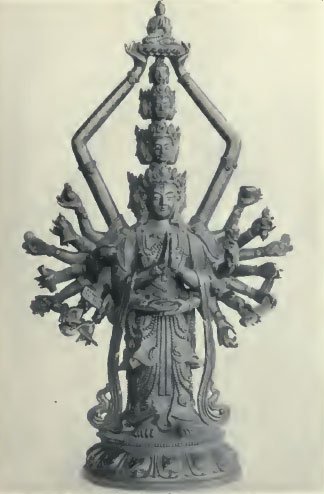 |
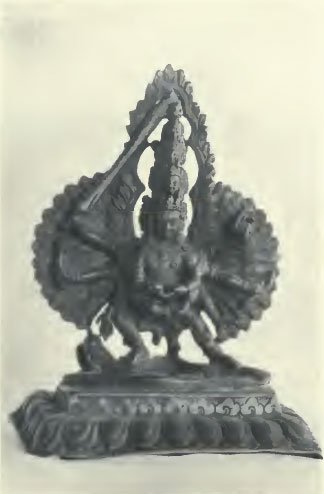 |
|
| a. Avalokitesvara | b. Avalokitesvara (?) | |
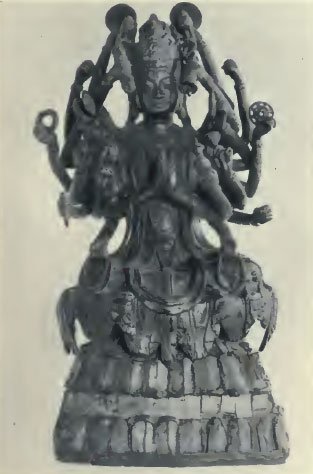 |
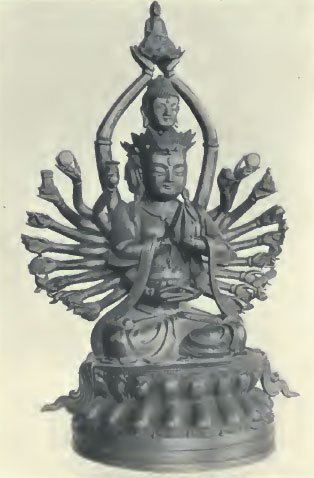 |
|
| c. Avalokitesvara (AmogHapasa) | d. Avalokitesvara | |
| PLATE XXIV |
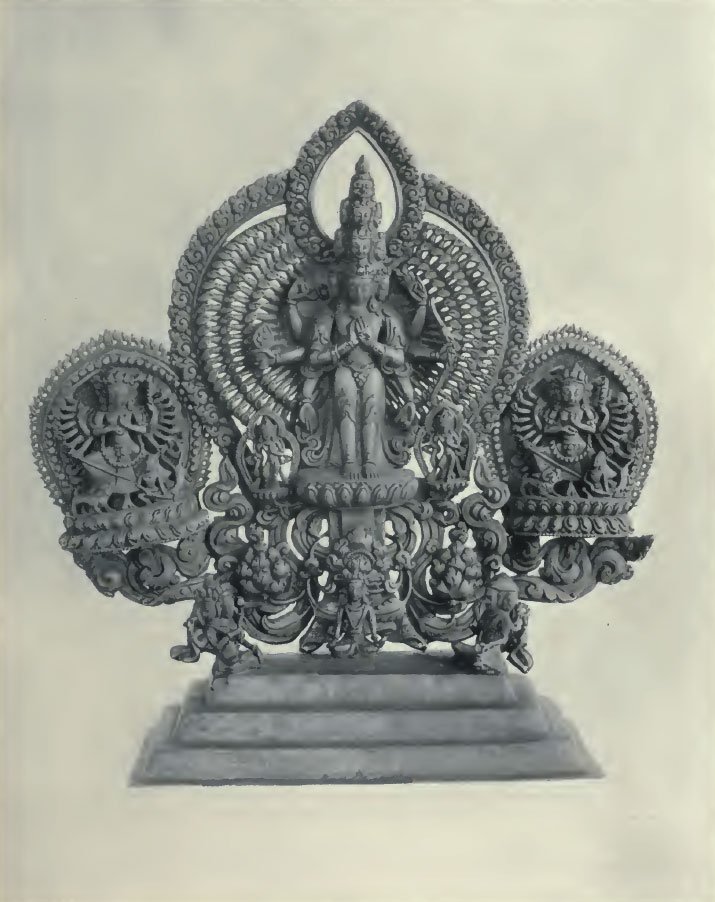 |
| Avalokitesvara '22,000 arms' |
| PLATE XXV | ||
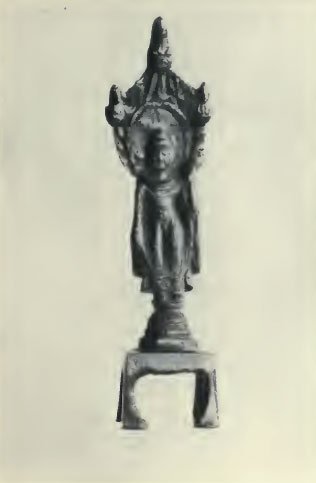 |
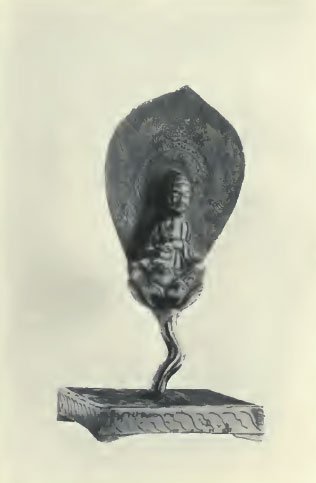 |
|
| a. Padmapani | b. Kwan-non (?) | |
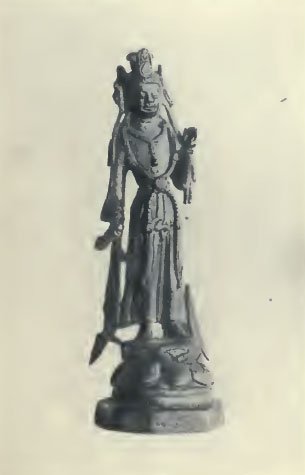 |
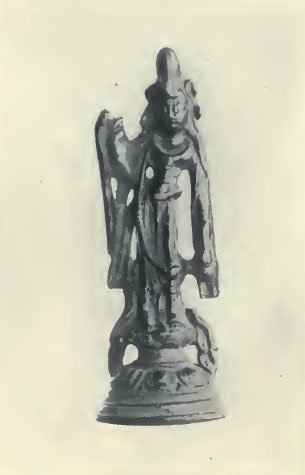 |
|
| c. Padmapani | d. Padmapani | |
| PLATE XXIV |
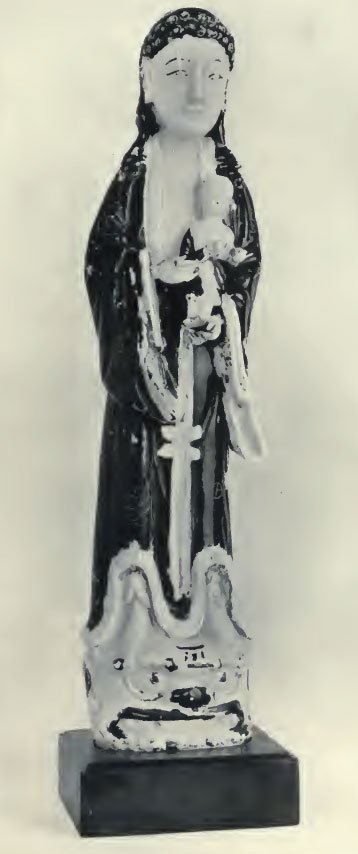 |
| Kwan-yin (Sung-tse) |
Footnotes and references:
[1]:
A. Foucher, Iconographie bouddhique, p. 94.
[2]:
Difficult to determine (Illus. PI. XXIII, fig. b).
[3]:
According to the Tibetans, 'the lord who looks', but European scholars give 'the lord of what we see', 'the revealed lord', 'the lord whom we see', or 'the lord with compassionate glances'.
[4]:
Avalokitelvara usually takes the colour of his spiritual father Amitabha (red) in Nepal. A. Foucher, Iconographie bouddhique, p. 99.
[5]:
A Tibetan historical work attributed to the Tibetan king Srong-tsan-gam-po.
[6]:
According to Hodgson the correct translation is: 'the mystic triform is in him of the jewel and lotus!' v. Om.
[7]:
Kasyapa Matanga is sometimes confounded with Kasyapa Buddha. He returned with the Emperor Mingti's mission to China A. d. 67, and is believed to have been one of the first disciples of Gautama Buddha in a previous incarnation.
[8]:
v. Burnouf, Introduction, p. 199.
[9]:
Demons who devour men.
[10]:
According to Beal, Avalokita is often spoken of as a white horse.
[11]:
Eitel, Three Lectures on Buddhism.
[12]:
v. Moor, The Hindu Pantheon, PL xv.
[13]:
A. Foucher, Iconographie bouddhique, p. 98,
[14]:
v. Sadhana.
[15]:
Mythologie bouddhique, p. 130. According to Theobaldus in his Physiologus, when a lion is born it lies for three days as if dead and is then awakened to life by the roarings of its sire, the lion.
[16]:
v. Waddell, Journal of the Royal Asiatic Society, Jan. 1894, PI. i.
[17]:
A. Foucher, Iconograj>hie bouddhique, Partie II, illust., p. 33.
[18]:
v. The Dhyani-Buddhas, and PI. xiv.
[19]:
v. Padma.
[20]:
v. Padmapani, with twelve emanations.
[21]:
v. Kwan-nom.
[22]:
v. Kalasa.
[23]:
Illustration, A. Foucher, Iconographie bouddhique, Partie II, p. 43, and A. Coomaraswamy, 'Mabayaua Buddhist Images from Ceylon', Journal of the Royal 'Asiatic Society of Great Britain and Ireland, April, 1909.
[24]:
This form may be the origin of the Pa-nan or 'Kwan-yin of the Eight Sufferings'.
[25]:
A. Foucher, Iconoyraphie buvddhique, Paitie II, p. 37.
[26]:
Hodgson, The Languages, Literature, and Religions of Nepal and Tibet, p. 88.
[27]:
Catalogue des Peintures nepalaises et tibetaines de la collection B. H. Hodgson a la Bibliolthegue de l'Institut de France, p. 26. According to M. Foucher, the pretas are receiving ambrosia from the fingertips of Padmapani, and there are three illustrations of this in the Nepalese MS. Add. 1643 in the University Library, Cambridge, where the ambrosia flows directly from his finger-tips into the mouths of personages or animals, v. PI. iv, no. 28, Foucher, Iconographie bouddhique.
[28]:
v. Bacot Collection, Musee Guimet, Paris,
[29]:
Called by the Japanese renge-no-in (v. Glossary) or the 'mudra of the lotus'. v. PI. lxiv.
[30]:
The middle fingers symbolize the element fire, and in this position represent the flame which is the symbol of Adi-Buddha. This mudra (with the fingers upright) is used by the Japanese priests in Buddhist ceremonies, and is called by them' nirvana' mudra.
[31]:
Foucher. Iconographie bouddhiqice, vol. ii, illustr., p. 33.
[32]:
Dawson, Classical Dictionary of Hindu Mythology.
[33]:
A. Foucher, Iconographie bouddhique. v. Sadhana.
[34]:
The sramana of the White Horse Temple, at Loh-yang, China, wore red robes during the Han dynasty. Parker, Studies in Chinese Religion,
[35]:
Siva's throat became blue after drinking the poison Hala-hala to save mankind.
[36]:
The Hala-hala is the poison which was churned from the ocean by the gods.
[37]:
This form is found in India with Vishnu seated on Garuda, who stands on a turtle, with a dwarf, one of the avatars of Vishnu, between his legs.
